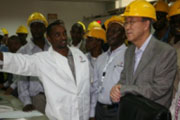According to the UN Environment Programme (UNEP), the programme has been collaborating with the National Power Generation Utility of Kenya (KenGen) to lower geothermal development costs through improved interpretation of geophysical data, and increasing the chances of hitting steam, thereby decreasing the number of unproductive wells.
 2 April 2011: UN Secretary-General Ban Ki-moon visited the Joint Geophysical Imaging (JGI) for the Geothermal Reservoir Assessment Project in Olkaria, Kenya, to witness the development of geothermal energy in Kenya’s Rift Valley.
2 April 2011: UN Secretary-General Ban Ki-moon visited the Joint Geophysical Imaging (JGI) for the Geothermal Reservoir Assessment Project in Olkaria, Kenya, to witness the development of geothermal energy in Kenya’s Rift Valley.
According to the UN Environment Programme (UNEP), the programme has been collaborating with the National Power Generation Utility of Kenya (KenGen) to lower geothermal development costs through improved interpretation of geophysical data, and increasing the chances of hitting steam, thereby decreasing the number of unproductive wells.
UNEP, with funding from the Global Environment Facility (GEF), contributed US$1 million towards total costs of US$2.7 million of the project, which included the training of KenGen scientists and technicians. According to UNEP, KenGen is now using its expertise to assist Rwanda, Eritrea and Zambia to assess and develop their geothermal resources.
According to UNEP, a regional project, titled African Rift Geothermal (ARGeo), is under development in six East African countries (Djibouti, Eritrea, Ethiopia, Kenya, Tanzania and Uganda) to tap into the Rift Valley’s unexplored geothermal potential. ARGeo will involve a GEF contribution of US$17million, to provide a platform for accelerated geothermal development and investment. [UNEP Press Release]